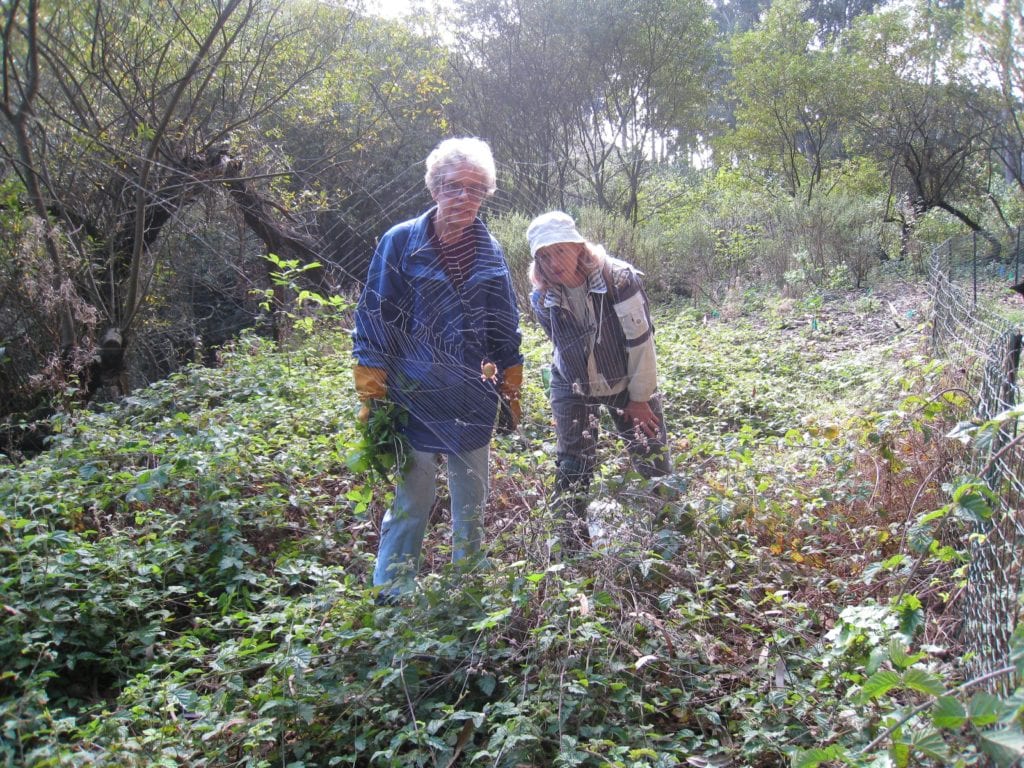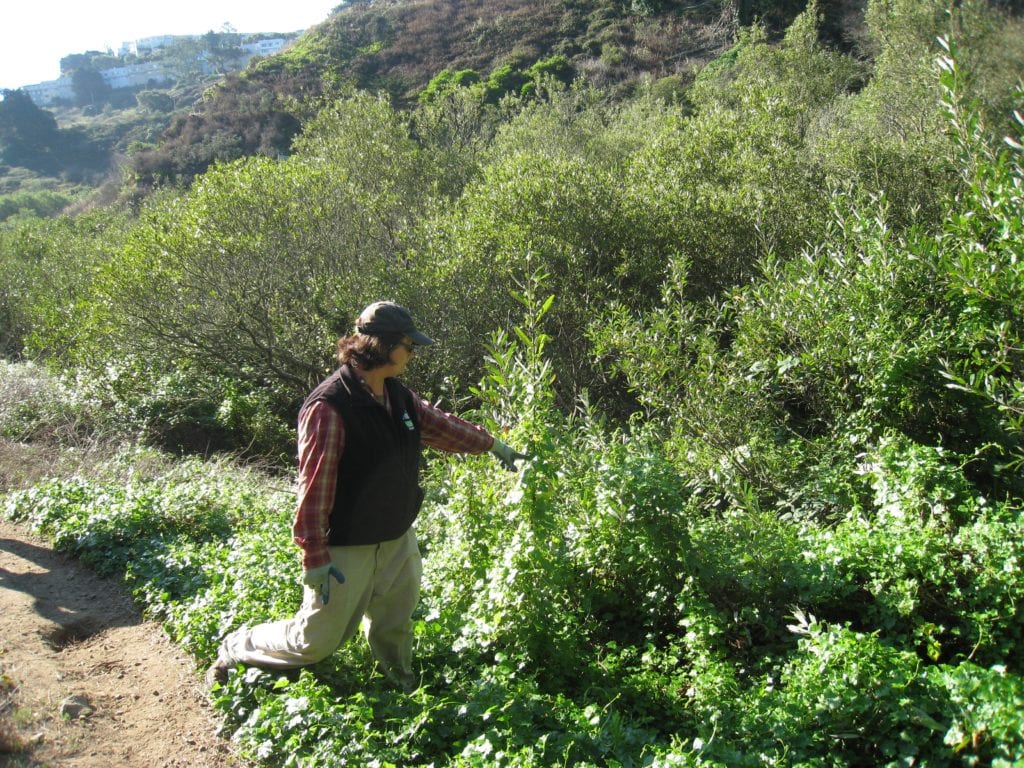
By Murray Schneider
On October 19th, two Friends of Glen Canyon Park volunteers, Mary Huizinga and Jean Conner, watched a pumpkin spider lying at the center of its geometrically designed web. It looked as if it hadn’t skipped a meal in at least an hour, suspended from a silken guy-wire, rigged taut between willow branches along the west side of Islais Creek.
Huizinga and Conner, in turn, walked along carpets of Cape ivy, which they were about to untangle and then uproot.
Beginning each fall, scores of female spiders crawl from their hidey-holes, always around Halloween, engineer webs wherever they can find a three-foot span, feast on insects, lay their egg sacs, and when the weather turns cold, die.
With the pumpkin spider reminding her of imminent Halloween festivities, Huizinga leaned over and inspected its rounded belly filled with bugs and babies.
“I make pumpkin pies each Halloween,” said Huizinga, who has lived on Laidley Street since 1984. “I scoop out the seeds and then bake the pies at 350 degrees.”
While the spider sunned itself, Huizinga and Conner began unraveling hydra-like ivy, an invasive and inimical perennial vine that roots from every leaf node, and has the ability to form dense ground cover or climb fences and trees. Left unattended, it smothers everything beneath it, usually resulting in the “host” plants dying due to lack of light.
Earlier, before Huizinga and Conner began their three-hour shift, Recreation and Parks Natural Areas gardener Rachel Kesel demonstrated the proper manner to extricate the intrusive vine that is native to South Africa.
“The ease with which it becomes entangled in other plants makes its removal difficult,” said Kesel, as she demonstrated how to unbraid the ivy threads that boasted shiny bright green and waxy leaves.
“If the ivy is intertwined with native plants,” Kesel continued her tutorial, “you’ll need to create access with loppers and then use a hand mattock to get underneath the soil to remove the root system.”
With Huizinga and Conner looking over her shoulder, Kesel demonstrated.
“Ivy stems can be easily broken during removal,” she cautioned. “The broken stems, which can reroot and start new plants, must be completely removed from the site.”
Cape ivy, which is actually not true ivy at all but a member of the sunflower family, is possibly the invasive most difficult to fight in California due to its growth habits and reproductive traits. It often grows in thick areas of poison oak and blackberry brambles, two plants that are not strangers to Glen Canyon. It is rampant throughout California’s coastal riparian areas, thriving in the cool, moist, often fog-drenched conditions in San Francisco.
It is the same habitat that pumpkin spiders savor and Rec and Parks gardeners and volunteers preserve.
Crawling on crab-like legs, the spider maneuvered along its web while the two volunteers wrestled armloads of interlaced ivy, stuffing it into yellow pop-up bags and tamping down the tendrils with the iron end of a mattock. A blue tarp lay unfurled not far from Islais cherry and pink flowering currant. Other volunteers, who begin work each Wednesday at 9 A.M., stockpiled more vines, bedding them on the tarp for subsequent disposal.
With a handful of ivy in her hand, Conner studied the somnolent spider. Conner, who lives on Sussex Street, also gardens along Penny Lane, the bucolic easement behind her home.
With its unpaved, rutted and unlit path, Halloween-costumed trick-or-treaters avoid Penny Lane, but the ghosts and goblins have no difficulty haunting Laidley Street, a few blocks from Castro Street where Huizinga lives.
“We pool bags of Snickers and Milky Ways with our neighbors,” said Huizinga, a retired IT systems programmer who walks her eight-year old Chow Chow Chester to Glen Canyon each day. “We sit on a stoop and drink wine and watch the kids dig into the candy.”
Bob, her husband, buys an extra bag, but Huizinga always hides it from him.
“As the wine disappears,” she said with a smile, “the treats in the bowls seem to go faster.”
Kesel who’d just eliminated another patch of colonizing Cape ivy poaching upon native plants, swung by and surveyed the morning labors. Pleased, she and a Natural Areas colleague, Jenny Sotelo, pummeled the ivy resting on the tarp, ready now for removal from the site. The two gardeners surveyed the area, ensuring that no vines hid in clandestine clumps camouflaged beneath unsuspecting foliage, waiting to re-establish themselves in the restored areas.
Satisfied, Kesel and Sotelo hauled the blue tarp to their waiting truck, where later they’d stuff the ivy into plastic bags, as the plants can remain viable for long periods of time, even contaminating compost and garbage.
Huizinga unbuckled the two knee guards that protected her knees and her soiled Carhartt jeans, now permanently stained with caked canyon dirt. The pumpkin spider, with her swollen abdomen, lay inert, waiting for prey. Huizinga slung a backpack across her shoulder and pulled at her white cap, preparatory to departing along Alms Road and exiting at Elk Street.
She had places to go and purchases to make.
Halloween was only days away and Walgreens had a sale on Reese’s Milk Chocolate Peanut Butter Pumpkins.
Anyone interested in volunteering in Glen Canyon can e-mail Joe Grey at Joe.Grey@sfgov.org or Richard Craib at richcraib@gmail.com
